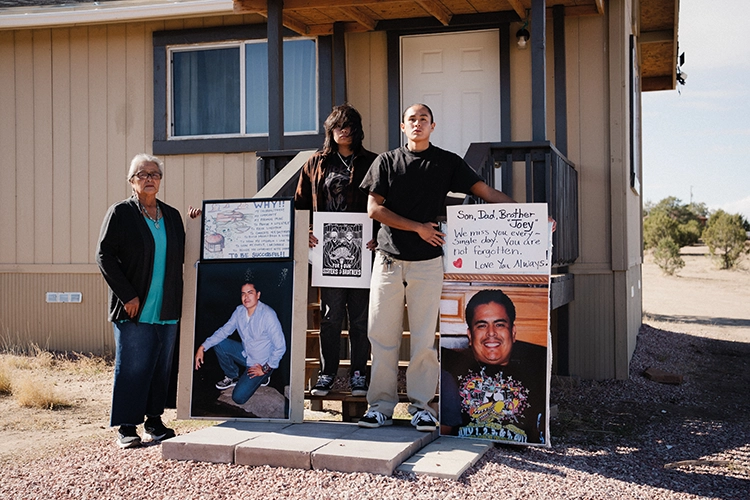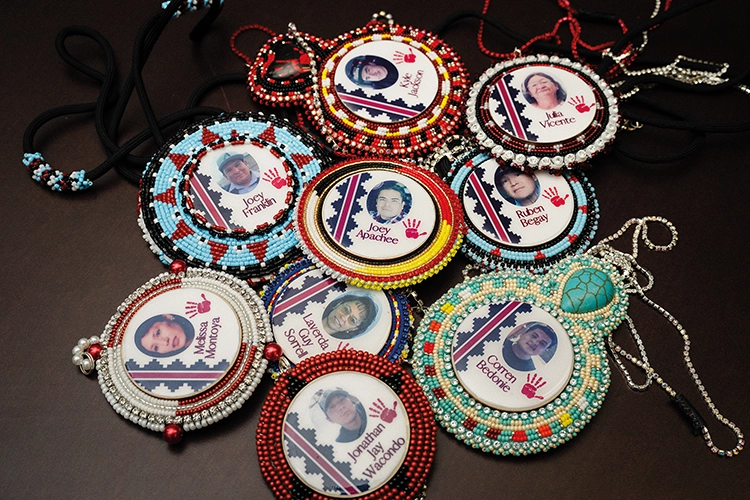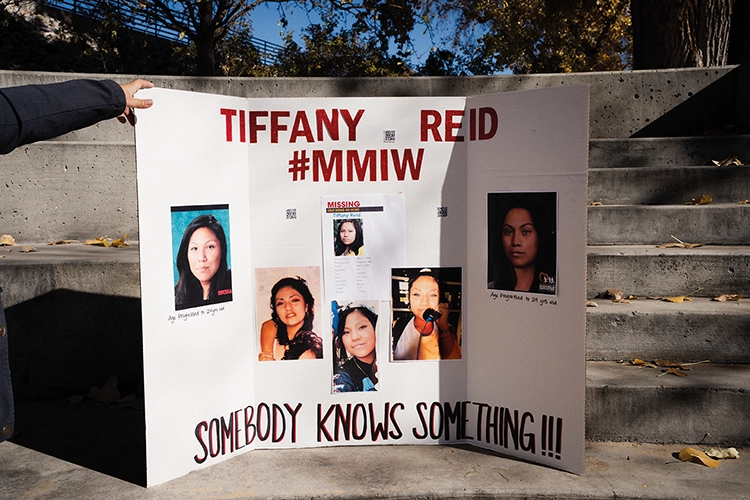
Families across the Navajo Nation are searching for justice amid a growing crisis of disappearances, stalled investigations, and a system that too often looks the other way
Words and photographs by Wayan Barre
On a cold January evening in 2021, Joey Apachee, a Navajo father of two, set out to meet a friend near the water tower in Steamboat, Arizona. Hours later, he was found beaten to death. His father, Jesse Apachee, a retired police officer, now spends his days searching for answers in a case that appears to have been abandoned by the justice system. ‘We have everything – evidence, a confession – yet no progress,’ he says. The confessed killer remains free, living just miles away. The family fears the consequences of inaction: ‘If they aren’t investigating this case, he could be out there committing other crimes. How can the community feel safe?’ Adding to their frustration, the family had to wait an entire year for Joey’s autopsy results.
As of 2021, 399,494 people were listed as part of the Navajo Nation, making it the largest federally recognised tribe in the USA. Of these, more than 165,000 live within the nation’s borders – an area larger than Scotland. Beneath this vast expanse, which straddles the states of Arizona, New Mexico and Utah, lies a harrowing crisis: the epidemic of Missing and Murdered Indigenous Relatives (MMIR). For generations, Indigenous families have confronted disappearances, violence and an indifferent justice system.
While their land holds deep cultural, historical and spiritual importance, it also presents logistical challenges. The isolation of the Navajo Nation in the southwest USA’s empty brushlands makes law enforcement difficult, with many communities accessible only by dirt roads, slowing response times and complicating investigations. Poor infrastructure and the vastness of the territory further hinder search-and-rescue efforts, often leaving families to conduct their own investigations with limited resources.
One of the greatest obstacles to addressing the MMIR crisis is the complex legal framework governing tribal lands. The Navajo Nation operates under a mix of tribal, state and federal jurisdictions, which often results in confusion over who is responsible for investigating crimes. Depending on the case, jurisdiction may shift between the Navajo Police, the Bureau of Indian Affairs (BIA), the FBI, or even state and local police. In addition, tribal law enforcement agencies lack the authority to prosecute non-Native perpetrators, forcing them to rely on federal agencies such as the FBI and BIA, which are often slow to respond and under-resourced.
Historical distrust between Indigenous communities and law enforcement has further complicated efforts to address MMIR. Decades of neglect, racial profiling and dismissive attitudes from outside agencies have created deep scepticism about the justice system’s willingness to prioritise missing Indigenous individuals. Families frequently report feeling ignored by authorities, with cases dismissed as runaways or accidents despite clear evidence of foul play.
Attorney Darlene Gomez, who represents MMIR families, puts it bluntly: ‘This is not happening in white communities.’ She adds, ‘It’s beyond a crisis, it is a genocide. Federal agencies are not investigating these crimes.’ This mistrust discourages some families from engaging with law enforcement, leading to underreporting and further complicating data collection.
Many Indigenous communities, including the Navajo, traditionally don’t speak openly about death due to spiritual beliefs, making it harder to mobilise awareness and resources. Economic hardship also plays a role, with poverty rates exceeding 35 per cent, more than double the national average. A lack of job opportunities forces many to leave the reservation, increasing their vulnerability to violence and trafficking.

Gomez, has witnessed the impact of these delays. Reflecting on the case of her friend Melissa Ann Montoya, who went missing in 2001, Gomez explains: ‘Various agencies wasted valuable time trying to determine who had jurisdiction.’ For grieving families, this bureaucratic maze adds further pain, delaying justice and leaving critical questions unanswered. Despite the dedication of individual law enforcement officers, the Navajo Nation Police Department remains critically underfunded and understaffed. Gomez, the only lawyer in the USA providing pro bono representation for MMIR cases, has seen the slow, indifferent response from various agencies. ‘There is a lack of resources, training, accountability, transparency and emergency response,’ she says.
While increased visibility has drawn public attention to the disproportionate violence faced by Native communities, it hasn’t led to systemic reform. Gomez describes the frustration many feel: ‘The media helps bring attention to some cases, and that can push authorities to act – but it’s not enough. While individual stories may get a temporary spotlight, there’s been no real structural change. Families still face delayed investigations, jurisdictional confusion and a lack of transparency from law enforcement. They’re not just advocating for their loved ones – they’re doing the work that institutions should be doing.’
The Navajo Police Department’s Missing Unit, one of the few dedicated MMIR law enforcement teams in the region, is tasked with partnering with search-and-rescue teams and working closely with families to document and track cases. But with just one sergeant, four patrol officers and three civilian staff members, it faces an overwhelming caseload. Overall, the Navajo Police Department has about 210 officers to patrol the entire Navajo Nation. With limited personnel and funding, they struggle to respond effectively to the crisis.
Indigenous people experience violence at significantly higher rates than any other community in the USA. According to the Urban Indian Health Institute, in some parts of the USA, Indigenous women are murdered at a rate ten times higher than the national average. Additionally, the National Crime Information Center recorded 10,123 missing Native American individuals in 2022, though the real figure is likely higher due to inconsistencies in reporting and data collection. In 2016, the FBI’s National Crime Information Center recorded 5,712 missing American Indian and Alaska Native women and girls, yet only 116 were entered into the Department of Justice’s federal database.

In recent years, the crisis has expanded to affect more men and boys, who now account for more than 46 per cent of cases. Economic hardship, lack of access to education and healthcare, and exposure to violence, substance abuse and trafficking make Indigenous men particularly vulnerable.
The Navajo Nation, like many Indigenous communities, remains trapped in a justice system that often fails to prioritise their safety and well-being. Navajo Nation President Buu Nygren has acknowledged the severity of the crisis, stating that it would be ‘a very difficult task to guarantee the safety of the Navajo Nation’ while individuals continue to go missing. Families like those of Joey, Ranelle, Zachariah, Tiffany and Calvin continue to face barriers that prevent them from obtaining the justice their loved ones deserve.
In the absence of meaningful government action, the families have become the frontline in the MMIR crisis as they try to bring their relatives home. For them, there is no option but to keep searching.
The disappearance of Calvin Willie Martinez

Calvin Willie Martinez disappeared on 12 May 2019 after calling his mother from a truck stop in Albuquerque, New Mexico, saying, ‘Mum, I’m going home.’ Despite this brief call, he was never heard from again. Calvin had endured profound loss – his girlfriend and youngest son died in a house fire in 2014. Throughout this time, he remained closely connected to his family.
In Calvin’s case, jurisdictional confusion impeded the investigation. Albuquerque police initially refused to take the case because Calvin was from Farmington; Farmington police, in turn, passed the case to another jurisdiction. This shifting of responsibility has complicated the search for answers.
Georgiana Harrison’s search for Ranelle Rose Bennett

The search for Ranelle Rose Bennett, who disappeared in 2021 near Shiprock – a border town within the Navajo Nation – is emblematic of the obstacles families face. Her sister, Georgiana Harrison, has fought tirelessly to find her and hold those responsible accountable. She is also raising Ranelle’s two children while navigating a justice system that continues to fail them.
The investigation into Ranelle’s disappearance has been marred by delays and a lack of progress. Her boyfriend, a key figure in the case with a history of gun violence, is currently in jail for other crimes. However, conflicting jurisdictions between tribal, state and federal authorities have complicated efforts to question him about Ranelle’s disappearance.
Two years on, Georgiana continues to distribute water bottles bearing Ranelle’s image in an effort to raise awareness and ignite conversations that she hopes will eventually lead to new information.
Zachariah Shorty: A mother’s fight for justice

Vangie Shorty has become a tireless advocate, driven by personal tragedy. She has endured the deaths of both her sons – one in a car accident, and Zachariah, who was murdered in 2020. Despite clear evidence and a confession from the suspect, Zachariah’s case has stalled, leaving Vangie without the justice she desperately seeks. The slow pace of the investigation and a lack of communication from authorities have only compounded her frustration and sense of powerlessness.
Her grief is palpable as she defies the cultural norm of silence around loss within the Navajo community, choosing instead to speak openly about her pain. ‘I feel that my boys are here with me,’ she says. By publicly sharing her story, Vangie hopes to prevent other families from enduring similar tragedies and to ensure that those responsible are brought to justice.
Tiffany Reid’s disappearance

Tiffany Reid, a 16-year-old from Shiprock, Navajo Nation, disappeared in 2004 while walking to school. The response from the Shiprock Tribal Police was disorganised, and her case was later purged from the NCIC database. Nearly two decades later, Tiffany’s sister, Deiandra, continues to advocate for justice.
As Land and Body Violence Coordinator at the Coalition to Stop Violence Against Native Women, Deiandra has dedicated herself to raising awareness about the MMIR crisis and confronting systemic failures such as jurisdictional silos and poor communication.




